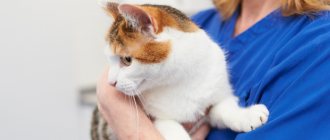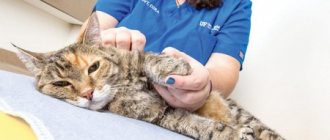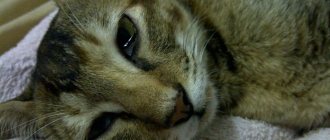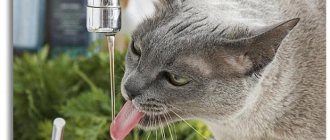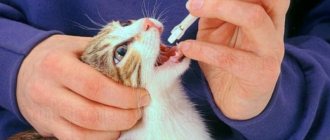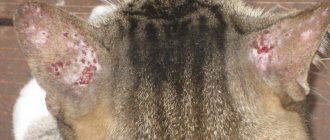Domestic cats can suffer from ectoparasites - those that live on the surface of their body. The most famous are ticks and fleas. Less common are lice-eaters, but these insects not only bring suffering to the animal, but are also dangerous to humans and other pets in the house.
Such a parasite spreads pathogenic microorganisms, and the risk of infection among others is quite high. Therefore, owners need to know what lice eaters look like in cats (from the photo), and what are the symptoms of their appearance. This information will help you take timely measures to rid your pet of a pest that poses a threat to its health.
Who are the lice eaters?
In Latin their name sounds like Felicola subrostratus. These are parasites from the family Trichodectes, which are not blood-sucking, but biting insects.
This louse grows no longer than 1-2 mm, it is yellowish, sometimes light gray in color, and translucent. Their jaws are designed like hooks, allowing them to grip skin and fur well. The parasite itself is flat, with three pairs of legs and a large (relative to the body) head. Their nutrition comes from keratin plates of the epidermis and hair. The disease caused by the vital activity of the pest is called trichodectosis.
Felicola subrostratus reproduce in the same way as head lice - by laying eggs, and one individual usually leaves behind up to 100 pieces, gluing them with mucus at the root of the hair. The development cycle from larva to adult takes 2-5 weeks, depending on conditions, and this is quite fast. Unlike ticks and fleas, such insects do not tend to change hosts.
Important : the parasite does not settle on the human body; it is “not satisfied” with scanty hair. But proximity to these insects still poses a threat of spreading the infection. Therefore, it is necessary to deal with them immediately.
What do you prefer to feed your pets?
Poll Options are limited because JavaScript is disabled in your browser.
Not all owners know that lice in dogs can lead to death. You won't know what lice eaters look like because they are microscopic, but you can notice the symptoms and signs of infestation.
This is interesting! Unlike their cousins, lice eaters can easily tolerate extreme temperatures and have been found in both hot and cold regions.
Are lice-eaters transmitted to humans from dogs?
Important! Hair loss when infected with lice can be irreversible.
Quite often, instead of making a correct diagnosis, the pet is treated for atopic dermatitis or of unknown origin. If you doubt the correctness of the diagnosis, it is better to take skin scrapings yourself and submit them to a “human” laboratory for diagnosis. This measure is especially wise if you live in a region where lice eaters are not widespread.
Unfortunately, lice-eater infestation in itself is not as dangerous as its consequences. Irritated, affected skin becomes fertile soil for fungi and microscopic mites. Usually, the first rebel is Demodex, which lives on the skin of healthy dogs.
In addition to being affected by lice eaters, the dog begins to develop demodicosis, and if left untreated, this leads to the appearance of extensive, weeping wounds.
Weeping wounds are accompanied by infection, which gives the disease a purulent character. Typically, at this stage, the dog's skin is so damaged that it does not fully recover. Without treatment, the animal dies.
The course of treatment can range from 14 to 40 days, depending on the degree of skin damage.
During the entire recovery period, the dog is given supportive therapy and symptomatic treatment. To recover, your pet needs rest and quality nutrition.
Due to constant itching, the dog develops anxiety and sleep disturbances, which leads to chronic fatigue and a decrease in the body's immune defense. To relieve this situation, the dog is prescribed immunostimulants.
Folk remedies for the treatment of lice in dogs
Treatment and medications you will need depend on the extent of the skin damage. Practice shows that when the lesion is at an advanced stage, it is practically impossible to restore hair growth.
The dog recovers, but bald patches remain on its body. Sometimes, regeneration of hair follicles occurs over several years. The lack of hair does not threaten the life of the dog, although it spoils its appearance; other consequences of infestation with lice are much more dangerous.
When the body's immune defense decreases and the temperature rises, it is almost guaranteed that the dog will develop demodicosis. The pathogen, which lived peacefully on the skin of a healthy dog, begins to actively multiply and infect large areas of the skin.
Depending on the type of pathogen, demodicosis can occur on the dog's paws, face and body. Treatment is extensive and complex. Usually the dog is treated several times with potent insecticide preparations.
In parallel, injections of antibiotics and antifungal drugs are given to prevent the situation from worsening. Treatment of demodicosis can last for months. Hair restoration is also questionable.
In the early stages of the disease, the reaction to toxins is expressed by dermatitis and severe itching. If left untreated, the dog will scratch the skin, which leads to wound infection, swelling, severe pain and the formation of pus. At this stage, broad-spectrum antibiotics and comprehensive supportive therapy are used.
Important! Blood poisoning always leads to enlarged lymph nodes, but this symptom is not indicative because it is often overlooked.
If the blood is damaged, recovery is impossible without therapy that supports the liver and kidneys. Usually, the kidneys are the first to suffer, which affects the functioning of the genitourinary system. The dog may experience uncontrollable thirst, low-concentrated urine, and pain on palpation in the spine and hip joints.
Drops are considered the most reliable and convenient means of prevention.
Typically, drops protect against fleas, ticks and lice. Some medications also protect your dog from mosquitoes, which is important if you live in a region where dirofilariasis is common. If you carefully read the instructions for the drops, you will find that they protect against fleas 2 times longer than against ticks. Since lice eaters are arachnids and belong to the family of mites, to prevent them, the dog must be treated more often.
Practice shows that the most effective drugs protect a dog for no longer than one month. For reliable prevention, your pet needs to be treated regularly all year round. The frequency of treatments can be reduced in winter, especially in frosty weather.
Preventative collars were invented to combat fleas and ticks; they do not particularly help against lice and subcutaneous ticks. Insecticides, which are released from the collar gradually, are absorbed into the skin and spread over its entire surface.
When figuring out whether lice eaters are dangerous for humans, you need to know what they look like. The insect is difficult to notice in the fur. Body length reaches 2 mm. The shape is slightly elongated, flattened. The top of the body is covered with a shell of chitin, which has a pale yellow tint. The head is slightly wider than the thoracic part. There are no wings, so they are not able to fly.
The female is fertile. Lays about a hundred tiny eggs, attaching each one with a special uterine secretion to the hair.
They feed on animal blood plasma, pet fur, and skin particles. For such an unusual way of feeding they received other names: lice eaters, wool eaters.
Signs of infection in animals
Lice eaters are found extremely rarely in humans; much more often they live in the fur of pets. They are transmitted through contact during walks or during mating.
Signs indicating the presence of insects in dogs and cats:
- itches constantly;
- scratches and wounds appear in the area of the tail, ears, hips, and neck;
- wool loses its attractiveness: tangles appear, bald spots are noticeable;
- white inclusions resembling sand are visible on the hairs (this is what nits look like);
- causeless howling of an animal during the day and night;
- pet's loss of appetite;
- the appearance of nervousness and aggression.
Can lice eaters transfer to humans?
One group of scientists came to the conclusion that, theoretically, if there is close contact between a pet and its owner, lice eaters can be detected in people; photographs prove this fact.
- constant itching of the skin;
- the appearance of bald spots on the scalp;
- nervous exhaustion, irritation.
If you suspect that a person has lice eaters, treatment can begin after examination by a specialist. Medicines that destroy lice will help get rid of insects, larvae, and nits.
There are several reasons for this:
- lack of thick wool;
- low body temperature for the life of lice eaters (in dogs, the normal temperature is 37.4º - 39.3).
However, the pest sometimes gets on the skin by accident, but cannot live there for a long time. If an insect crawls onto the body, it can remain there for a short period. They are unable to reproduce due to the lack of suitable conditions. The only danger posed by them is a bite.
Reasons for appearance
The appearance of lice eaters in cats occurs through infection, that is, by contact. It could be:
- direct contact with relatives - games, sexual intercourse or fighting;
- objects - dirty clothes and shoes of people, bedding, comb;
- relatives - kittens become infected from their mother;
- hunting - mice and rats can be carriers, but these are extremely rare cases.
There are also secondary factors that most often cause lice in cats:
- keeping a large number of cats in one place in the absence of proper hygienic conditions;
- increased humidity in the house where animals live;
- immunodeficiency - the sebaceous glands in cats in normal condition limit the number of ectoparasites;
- lack of nutrition;
- winter-autumn is the period of greatest activity of Felicola subrostratus;
- old age of the animal.
How does infection occur?
In most cases, lice-eaters are transmitted through direct contact of a healthy animal with a carrier animal. Less commonly, infection occurs indirectly, when lice eaters move from one animal to a person or to any other object, and then end up on another pet.
Contact of a healthy animal with an infected one is the simplest way of infection.
The highest likelihood of infection with these lice is in those pets who live too crowded, which leads to frequent contacts between individuals, as a result of which lice-eaters quickly move between carriers and reproduce. This is why lice can often be found on animals taken from nurseries or overcrowded shelters.
The rapid spread of lice-eaters is also facilitated by:
- poor nutrition/lack of it;
- failure to comply with hygiene standards in places where animals gather;
- living on the territory of a shelter, nursery or owner's house of infected rodents that have access to cats.
Due to overcrowding in shelters, animals in them are susceptible to all kinds of epidemics.
As a result of the influence of these three main factors, cats' resistance to this parasite decreases, which is why invasion occurs. Animals with strong immunity, living in comfortable conditions, on the contrary, have a high resistance to lice, even when the latter gets on the cat’s fur.
Symptoms of the presence of lice in cats
You can recognize the signs of your pet being infected with cat lice by its uncharacteristic habits:
- restless behavior, irritability;
- sleep disorders;
- absent-mindedness, lethargy and weakness;
- biting fur when licking;
- constant scratching.
Also pay attention to external changes:
- general unhealthy appearance of the fur;
- Wounds and abrasions appear on the cat’s skin from scratching and biting. He applies them himself, trying to get rid of severe itching and parasites;
- the appearance of rashes, roughness and inflammation on the skin;
- dandruff;
- baldness - sometimes similar to seasonal shedding, but sometimes it can be isolated areas. Hair loss occurs in advanced cases when there are a large number of parasites.
Clinical picture
When a lice eater is detected, the following signs appear:
- The appearance of small white elements resembling.
- Ungroomed appearance of the coat.
- Sharp weight loss.
- Severe anxiety.
- Distracted attention.
- Behavior change.
The lice eater causes itching in dogs.
The dog may itch severely for several days. Hair falls out so profusely that baldness occurs as a result.
The skin at the site of baldness swells and becomes wrinkled. It becomes covered with a gray crust. And also specific scabs are found on the skin.
The dog becomes very nervous and may stop listening to commands.
Initial examination
If you notice the symptoms listed above, then this is a signal for a detailed examination of your pet.
- Bring the animal to a bright directional light - under a table lamp or flashlight.
- If possible, equip yourself with a magnifying glass or other optics.
- Run your hands through the wool and carefully examine the fibers.
- First, examine the cat's head and neck, then the groin area and the base of the tail.
With the naked eye or with a slight magnification, you can see traces of the vital activity of lice - black dots that can be located at the base of the hairs. This is parasite excrement. The pest itself is more difficult to detect, since the insect is very small and translucent. Moreover, unlike fleas, it does not jump, but is inactive.
Tip : lice eaters are heat-loving insects, so you can “lure” them to the surface of the fur by briefly holding your pet near an electric lamp or heater. After 10-15 minutes, the ectoparasites will become more noticeable - tiny dots will appear on the tips of the cat's hair.
If, after following the steps described, you are convinced that your animal has lice, then a visit to the veterinarian is necessary. The specialist will take a scraping and perform the necessary tests to determine the degree of infection and prescribe treatment. You should also make sure that the cat has not developed a disease that reduces immunity, the risk of which is high with a prolonged attack of the parasite.
How to recognize the presence of parasites
Cat owners do not always understand what type of insect attacked their pet. Among the parasites: ear mites, fleas, various worms. It is not difficult to detect lice eaters if you carry out a simple examination.
How to proceed:
- turn on a table lamp or go to a sunny window;
- put the animal under a light source or leave it to bask in the sun;
- Whipworms love warmth; quickly enough they will rise from the skin to the tips of the hairs. The owner will notice small, light yellow parasites.
The following signs indicate the reproduction of lice eaters:
- constant, unbearable itching in a pet;
- the cat actively licks its fur and bites off parasites with its teeth;
- the pet is restless, sleeps poorly, does not sit still for a long time;
- Dangerous pests are noticeable on the fur and skin;
- the cat becomes disobedient, attention decreases, “mousecatchers” lose interest in hunting;
- wounds, marks from bites, scratches remain on the skin;
- the animal’s body and fur take on an unkempt appearance, the skin often peels off and becomes inflamed;
- hairs become thinner, often fall out, bald areas become inflamed and covered with scratches;
- the animal loses interest in games, becomes restless, and suffers greatly from constant bites of blood-sucking parasites.
Treatment
A pet affected by lice requires urgent treatment to avoid side diseases such as allergies or miliary dermatitis. To combat such parasites, you can purchase drugs in the form of drops, emulsions, sprays, shampoos and liquids in ampoules, as well as collars, in veterinary pharmacies or specialized stores.
Important: before treating your cat for ectoparasites, carefully read the instructions. You cannot change the indicated dosage of the medicinal substance! This will harm the health of the animal.
Drops
Most antiparasitic drugs are toxic, so you should apply the medicine in those places where the cat is not able to lick them off - this is the head, withers and the area along the spine. The liquid is rubbed into the skin, evenly distributing the contents of the pipette over the surface. Drug treatment usually protects against lice for a month, after which it should be repeated. But in any case, it is better to read the instructions from the manufacturer.
The most popular drugs are:
- Frontline Combo Cat - from Merial, France (450-500 rubles);
- Stronghold - from Zoetis (a division of Pfizer), USA (480-550 rubles);
- Fiprex - from 3PIP, Poland (about 250 rubles);
- BARS - from AGROVETZASCHITA, Russia (150-200 rubles);
- “IN-AP complex” (about 200 rubles)
Emulsion
To use antiparasitic emulsions, they are diluted with water, so such products are essentially the same drops. In addition, the method of using them is no different - the solution is rubbed into the animal’s skin in the area of the head, withers and along the spine so that the cat cannot lick it.
Today, both in Russia and in the CIS countries, emulsions from manufacturers are popular:
- Merial, France;
- Zoetis (a division of Pfizer), USA;
- AGROVETZASCHITA, Russia.
- BIONICS, Russia.
- IMPEX, Russia.
Spray
Currently, the best way to protect your cat from lice is an aerosol spray. This preparation can be sprayed over the entire body of the animal, with the exception of dangerous areas - eyes, nose and mouth.
After the time specified in the instructions for each drug, the pet is allowed to bathe in warm water with soap or shampoo. But until this moment you will have to keep an eye on him so that he does not lick his fur (the spray is toxic). If we are talking about several hours of action of the product, then the cat can be wrapped in a blanket or sheet. When the waiting time is measured in days, it is better for the animal to wear a special collar.
After a week, if necessary, the procedure should be repeated.
The most effective insectoacaricidal sprays include:
- BARS - from AGROVETZASCHITA, Russia;
- DELIX - from Delix, Russia;
- Dombrokhim FOS - from Rosagroservice, Russia;
- Bolfo - from Bayer, Germany;
- biospray GreenFort, Germany.
Shampoo
The safest way to kill lice in cats is shampoo. The animal is simply bathed, soaping the entire body and trying to ensure that the foam does not get on the mucous membrane of the eyes, nose and mouth. But if we talk about effectiveness, the drug is significantly inferior to the means described above, and its use in advanced forms of trichodectosis makes virtually no sense.
In this case, there are quite enough domestic drugs on the market:
- LUGOVOY;
- PHYTOELITE;
- Sweetie:
- BIOBAKS;
- CELANDINE;
- ROLF CLUB.
Ampoules
Such insectoacaricidal agents are akin to drops and gels. The drug is diluted with water and rubbed into the skin in the area of the head, withers and spine - it is also toxic. When purchasing, pay attention to the instructions - the dosage is indicated there, which may vary depending on the brand. Today you can buy in veterinary pharmacies and specialized stores for animals:
- FIPRIST COMBO;
- UNOSTOMIZED;
- ECTOSAN;
- BUTOXSEPT.
Caution: It is highly not recommended to use several different toxic agents simultaneously or within a short period of time one after another. This can lead to allergies or poisoning of the animal.
Collar
This insectoacaricidal agent is used to protect cats from ticks, fleas and lice, that is, against almost all ectoparasites that most often attack domestic pets. The validity period of such a device is usually limited to three months, but this is quite a long period. Plus, you don't have to do any additional processing.
Collars are:
- gas - they are made of polyvinyl chloride (PVC) or rubber. Inside contains microcapsules with poison (insecticide) that kills parasites;
- radiating - usually made of plastic. Repels insects with electromagnetic waves;
- ultrasonic is a fabric collar with devices attached to it that emit ultrasound, which is not perceived by the human ear, but repels all parasites. As an analogue, this could be an ultrasonic keychain - it can be attached to a regular collar;
- herbal, or biocollars - they are made of rubber impregnated with vegetable oils and essential extracts, which ectoparasites are afraid of.
Danger and consequences from lice eaters
Treatment for lice eaters usually does not cause significant difficulties, and their bites are not as painful as those of many other parasitic insects.
It is for this reason that many cat owners clearly underestimate them, and the presence of pests in some situations can even lead to death if the necessary measures are not taken in a timely manner. This threat is not posed by lice bites, but by the various side effects and negative consequences that they cause.
First of all, it is necessary to highlight the following nuances:
- The insects themselves can be carriers of other smaller, but extremely dangerous parasites. First of all, these are various types of worms and helminths, the infection of which is much more severe for a cat, and it will be very difficult to remove such pests. The risk of such infection increases significantly if the animal accidentally swallows at least one lice-eater.
- Insects can be infected with various diseases that they can infect a cat with.
- There is a possibility of complications if the infected cat has hypersensitivity or very delicate skin. Most often they manifest themselves in the form of small swelling or local inflammatory processes. It is not they themselves that are dangerous, but the animal’s scratching of these places, which can result in infection, activation of subcutaneous mites, the formation of fungi, or damage by various microbes.
In addition to the acute complications mentioned above, lice-eater infection itself in most cases causes the following consequences:
- Exacerbation of the pet’s existing chronic diseases.
- The occurrence of anemia.
- Exhaustion of the body.
- Partial baldness.
- External unattractiveness of wool.
- Manifestation of an allergic reaction to bites.
How to treat with folk remedies
Small kittens, and even some adults, have delicate skin that cannot be treated with drops and gels - this can cause allergies.
In this case, the animals are bathed in a decoction of wormwood, field chamomile, wild garlic or string. The essential oils contained in these herbs act as an insect repellent, so they try to leave their host as quickly as possible.
The decoction is prepared as follows:
- For 100 g of dry herb - 2 liters of boiling water, pour in an enamel or glass container. If the raw materials are fresh, then take 500-600 g of the medicinal plant.
- Place in a water bath for half an hour, or on very low heat for 15 minutes.
- Remove from heat and let sit covered for one hour.
- Strain.
- Pour into a bath or basin, add warm, clean water, and wash your pet.
Such bathing should be done several times until the lice-eaters disappear. But this procedure is effective only in the early stages of the disease.
Caution : some owners use dust or chloramine to cure their animal from trichodectosis, but this is dangerous! The drug gets into the scratches, and the animal experiences unbearable pain. And if the cat begins to lick sore spots, it may get poisoned.
Consequences of inaction or improper treatment
If you do not take urgent measures to treat cats for trichodectosis, this can seriously aggravate the situation:
- Felicola subrostratus are carriers of other diseases, for example, hemobartonellosis or helminthic infestations - there is a risk of infection;
- danger of acute allergies;
- exacerbation of chronic cat diseases;
- the risk of developing bacterial and fungal skin lesions against the background of a secondary inflammatory infection;
- the appearance of subcutaneous mites;
- baldness, exhaustion and a sharp decrease in the animal’s immunity;
- a pregnant cat will infect its offspring, which may not survive.
For these reasons, immediate action is necessary when a parasite is discovered in a pet.
Signs, symptoms, diagnosis
Symptoms develop quickly, because mites feed immediately as soon as they touch the skin. Common signs of parasites include:
- severe itching in the area of the tail, neck, thighs and ears, the skin turns red, and after a day or two wounds appear with poorly healing scabs;
- the dog’s coat becomes dull, rolls into tangles, and in short-haired breeds it puffs up with an unkempt appearance;
- if treatment is not started, bald patches occur (which can also be a sign of lichen);
- the pet loses its appetite, becomes restless, loses sleep, and is constantly thirsty.
If you do not attend to therapy, trichodectosis will lead to the development of:
- allergies;
- dermatitis;
- bacterial and fungal infections.
In addition, lice eaters carry leptospirosis, a very dangerous disease for dogs: puppies die from it within a couple of days.
The fact is that these mites love warmth, so they can be lured to the ends of the hairs by leaving the pet under the sun or a lamp, which will heat up its fur.
Another option is to cover the animal with a warm, dark-colored cloth, which will lure out the parasites. Their larvae can be seen: they look like dandruff and grains of sand that cannot be removed from the skin.
Is there a danger to humans?
The question of whether people can have lice eaters causes a lot of controversy, and opinions are divided almost equally. In theory, this is, of course, possible, but in this case it is necessary for the cat to sleep on a pillow with the owner, whose lice will settle in the scalp. But it is almost impossible for the parasite to survive in such conditions, since Felicola subrostratus will simply die from the cold without a sufficient amount of thick fur.
However, in close contact with a sick animal, a louse can accidentally bite a person. And then there is a risk of infection with cucumber tapeworm, fungi, bacteria, and the development of allergic reactions.
Caution : children are especially vulnerable; do not allow them to play with a cat carrying ectoparasites until it is treated.
Biology of parasites
A pet can become infected from street dogs and cats, as well as basement rats. In order to crawl from the fur of one individual to another, close contact is required. These insects do not have the jumping ability of fleas.
A kitten may also have parasites transmitted from an infected cat.
Nature has not endowed lice eaters with the ability to pierce the skin of the host in order to get enough blood. Therefore, insects are content with animal fur and exfoliated particles of the epidermis. For this purpose, they have a well-developed gnawing apparatus.
Expert opinion
Kalado Irina Sergeevna
Practicing veterinarian, 13 years of experience.
When it’s time to reproduce, the lice eater needs protein - without it, eggs cannot be formed. This is where the animals themselves come to the rescue.
The active movement of parasites across the skin causes itching, and the cat begins to scratch, scratching the skin until it bleeds.
Lice eaters gather at the edge of the wound. Having fed on blood, they crawl to the side (but not far) to lay eggs . For reliability, the offspring is attached to the hairs with a special adhesive substance in which the nits are enveloped.
In 21 days in warm conditions and a week later in winter, the larvae develop into sexually mature individuals. Those, continuing the life cycle, will quickly multiply the colony of parasites.
Does the infection affect the cat's appearance? Yes, because insects feed on animal fur. With severe damage, bald spots may appear on the body.
They also appear from scratching. The sticky mass holds the eggs on the bristles and clumps the fur into tangles that are difficult to comb out.
Harm from parasites to animals
A spoiled appearance is the most harmless of the problems caused by parasites.
Scratches on the body of cats are an excellent gateway for fungal and bacterial infections. Once microorganisms get into the wounds, the itching intensifies many times, forcing the cat to intensively scratch the skin.
As the inflammation site grows, it attracts arthropods.
In search of food, lice eaters travel throughout the animal's body.
They do not disdain the area near the anus. There, insects can “feast” on the eggs of the cucumber tapeworm. Those, once in the intestines of the parasite, turn into procercoids.
If a pet accidentally ingests an infected lice eater, the transformation of the intestinal parasite into a sexually mature individual will occur inside the animal. The cat will become a carrier of cestodes.
Is the lice eater dangerous for humans?
Some claim that these pests are not capable of harming people, such as fleas or ticks. After all, they need animal fur to develop.
But there is a risk for humans. While interacting with a cat, the owner may accidentally swallow a microscopic lice eater. This leads to infection with cucumber tapeworm.
Dipylidia provokes disruption of the digestive system, causing allergic reactions and the development of anemia.
When a person is infected with a tapeworm, the following symptoms are observed:
- stomach ache;
- nausea;
- itching in the anus;
- insomnia.
Children are usually infected with helminths: they are more likely than adults to have close contact with pets.
Preventive measures
As you know, it is much easier to prevent a disease than to treat it. Therefore, you need to follow some rules:
- try to exclude your pet from contact with sick animals;
- buy an anti-parasitic collar of any type, especially if the cat takes frequent walks outside;
- keep the litter clean, and while bathing, add a decoction of the herbs mentioned in the section “Folk Remedies”;
- pay more attention to the animal - regularly inspect its fur, notice the slightest changes in its behavior and activity;
- undergo a medical examination by a veterinarian at least once a year, especially in the spring, during the animal’s sexual activity. At the same time, you can find out whether the ratio of your pet’s height and weight is optimal.
Infestation of domestic cats with lice eaters is not very common, but none of the owners can guarantee that their pet will never be infected. However, if detected in time, parasites can be easily removed with the help of effective veterinary drugs offered today. The main thing is not to let the disease get worse, and many unpleasant consequences will be prevented.
Is it possible to prevent a cat from becoming infected with this ectoparasite?
To prevent lice-eaters from infecting these pets, it is recommended to follow these rules:
- Use special insecticidal collars. Brands such as Delix-D, Hartz, Bolfo, Beaphar, Bars, Gamma, Biocollar, Celandine have proven themselves well in preventing the appearance of various kinds of ectoparasites.
- Conduct regular inspections of the animal's fur to identify parasites. It is recommended to do this at least once a month. This procedure is indicated even for those pets who do not go outside.
- Wash with special shampoo.
- Carry out deworming in a timely manner. This manipulation will protect your pet not only from lice eaters, but also from other types of parasites.
- Avoid contact between your cat and stray animals while walking outside. It is recommended to walk your pet on a leash with a harness.
- Carry out regular preventive veterinary examinations. This should be done at least once a year. This measure will allow timely identification and elimination of signs of various diseases that can lead to a weakening of the animal’s immunity.
- Provide your pet with a balanced diet. When feeding a cat with prepared food, it is recommended to give preference to high-quality brands. You should also periodically give the animal vitamin and mineral complexes, having previously agreed on this issue with your veterinarian.
- Properly care for your pet.
- Do not allow your pet to be constantly exposed to drafts.
- Regularly clean the cat's litter box, wash (preferably using a disinfectant) bowls, and wash the bed.
- If your pet is infected with trichodectosis, isolate it from other animals living in the house. This will prevent the spread of infection among healthy pets.
- If rodents appear in your home, immediately take measures to destroy them.
- Having adopted a cat from a nursery or shelter, immediately treat it with an antiparasitic agent and check whether it has ectoparasites.
A parasitic disease in dogs caused by the lice-eater trichodectes canis is called trichodecticosis or mallophagosis.
As a result of insect attacks, animals suffer from itching, baldness, and the development of general weakness. The lice eater can also cause exacerbation of chronic diseases, cause infection or contribute to the occurrence of anemia.
